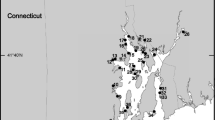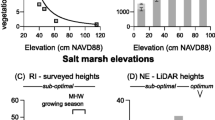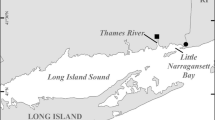Abstract
Sea level rise is a major stressor on many salt marshes, and its impacts include creek widening, ponding, vegetation dieback, and drowning. Marsh vegetation changes have been associated with sea level rise across southern New England, but most of these studies pre-date the current period of rapidly accelerating sea level rise coupled with episodic events of extreme increases in water levels. Here, we combine data from two salt marsh monitoring and assessment programs in Rhode Island that were designed to assess marsh responses to sea level rise and use these data to document temporal and spatial patterns in marsh vegetation during the current period of extreme water level increases. Vegetation monitoring at two Narragansett Bay salt marshes confirms the ongoing decline of the salt meadow species Spartina patens during this period as it becomes replaced by Spartina alterniflora. Bare ground resulting from vegetation dieback was significantly related to mean high water levels and led to the rapid conversion of mixed Spartina assemblages to S. alterniflora monocultures. A broader spatial assessment of RI marshes shows that S. alterniflora dominance increases at lower elevation marshes toward the mouth of Narraganset Bay. Our data provide additional evidence that S. patens continues to decline in southern New England marshes and show that losses can accelerate during periods of extreme high water levels. Unless adaptive management actions are taken, we predict that marshes throughout RI will continue to lose salt meadow habitat and eventually resemble lower elevation marshes that are already dominated by S. alterniflora monocultures.





Similar content being viewed by others
References
Alber, M., E.M. Swenson, S.C. Adamowicz, and I.A. Mendelssohn. 2008. Salt marsh dieback: an overview of recent events in the US. Estuarine, Coastal and Shelf Science 80: 1–11.
Bayard, T.S., and C.S. Elphick. 2011. Planning for sea level rise: quantifying patterns of Saltmarsh Sparrow (Ammodramus caudacutus) nest flooding under current sea level conditions. The Auk 128: 393–403.
Bertness, M.D. 1991. Zonation of Spartina patens and Spartina alterniflora in a New England salt marsh. Ecology 72: 138–148.
Bertness, M.D., P.J. Ewanchuk, and B.R. Silliman. 2002. Anthropogenic modification of New England salt marsh landscapes. Proceedings of the National Academy of Sciences 99: 1395–1398.
Blum, M.D., and H.H. Roberts. 2009. Drowning of the Mississippi Delta due to insufficient sediment supply and global sea level rise. Nature Geoscience 2: 488–491.
Boon, J.D. 2012. Evidence of sea level acceleration at U.S. and Canadian tide stations, Atlantic coast, North America. Journal of Coastal Research 28: 1437–1445.
Bozek, C.M., and D.M. Burdick. 2005. Impacts of seawalls on saltmarsh plant communities in the Great Bay Estuary, New Hampshire USA. Wetlands Ecology and Management 13: 553–568.
Bricker-Urso, S., S.W. Nixon, J.K. Cochran, D.J. Hirschberg, and C. Hunt. 1989. Accretion rates and sediment accumulation in Rhode Island salt marshes. Estuaries 12: 300–317.
Britton, W.E. 1912. The mosquito plague of the Connecticut coast region and how to control it. Connecticut Agricultural Experiment Station Bulletin 173: 16.
Bromberg, K.D., and M.D. Bertness. 2005. Reconstructing New England salt marsh losses using historical maps. Estuaries 28: 823–832.
Burdick, D.M., and C.T. Roman. 2012. Salt marsh responses to tidal restriction and restoration. In Tidal marsh restoration: a synthesis of science and management, ed. C.T. Roman and D.M. Burdick, 373–382. Washington: Island Press.
Cahoon, D.R., and G.R. Guntenspergen. 2010. Climate change, sea-level rise, and coastal wetlands. National Wetlands Newsletter 32: 8–12.
Carey, J.C., S.B. Moran, R.P. Kelly, A.S. Kolker, and R.W. Fulweiler. 2015. The declining role of organic matter in New England salt marshes. Estuaries and Coasts. doi:10.1007/s12237-015-9971-1.
Church, J.A., P.U. Clark, A. Cazenave, J.M. Gregory, S. Jevrejeva, A. Levermann, M.A. Merrifield, G.A. Milne, R.S. Nerem, P.D. Nunn, A.J. Payne, W.T. Pfeffer, D. Stammer, and A.S. Unnikrishnan. 2013. Sea level change. In Climate change 2013: the physical science basis. Contribution of Working Group I to the Fifth Assessment Report of the Intergovernmental Panel on Climate Change, ed. T.F. Stocker, D. Qin, G.-K. Plattner, M. Tignor, S.K. Allen, J. Boschung, A. Nauels, Y. Xia, V. Bex, and P.M. Midgley, 1137–1216. Cambridge and New York: Cambridge University Press.
Clarke, K.R., and R.M. Warwick. 2001. Change in marine communities: an approach to statistical analysis and interpretation, 2nd edition. PRIMER-E: Plymouth.
Clarke, K.R., and R.N. Gorley. 2006. PRIMER v6: user manual/tutorial. PRIMER-E:Plymouth.
Coverdale, T.C., N.C. Hermann, A.H. Altieri, and M.D. Bertness. 2013. Latent impacts: the role of historical human activity in coastal habitat loss. Frontiers in Ecology and the Environment 11: 69–74.
Craft, C., J. Clough, J. Ehman, S. Joye, R. Park, S. Pennings, H. Guo, and M. Machmuller. 2009. Forecasting the effects of accelerated sea level rise on tidal marsh ecosystem services. Frontiers in Ecology and the Environment 7: 73–78.
Deegan, L.A., D.S. Johnson, R.S. Warren, B.J. Peterson, J.W. Fleeger, S. Fagherazzi, and W.M. Wollheim. 2012. Coastal eutrophication as a driver of salt marsh loss. Nature 490: 388–394.
Donnelly, J.P., and M.D. Bertness. 2001. Rapid shoreward encroachment of salt marsh cordgrass in response to accelerated sea level rise. Proceedings of the National Academy of Sciences 98: 14218–14223.
Durant, D., and K.B. Raposa. 2011. Water quality, nutrients, and meteorological trends at the Narragansett Bay National Estuarine Research Reserve in 2009. Narragansett Bay National Estuarine Research Reserve. Technical Reports Series 2011:1. 46 pp.
Emery, N.C., P.J. Ewanchuk, and M.D. Bertness. 2001. Competition and salt marsh plant zonation: stress tolerators may be dominant competitors. Ecology 82: 2471–2485.
Erwin, R.M., G.M. Sanders, D.J. Prosser, and D.R. Cahoon. 2009. High tides and rising seas: potential effects on estuarine waterbirds. Studies in Avian Biology 32: 214–228.
Gedan, K.B., M.L. Kirwan, E. Wolanski, E.B. Barbier, and B.R. Silliman. 2011a. The present and future role of coastal wetland vegetation in protecting shorelines: answering recent challenges to the paradigm. Climate Change 106: 7–29.
Gedan, K.B., A.H. Altieri, and M.D. Bertness. 2011b. Uncertain future of New England salt marshes. Marine Ecology Progress Series 434: 229–237.
Goddard, P.B., J. Yin, S.M. Griffies, and S. Zhang. 2015. An extreme event of sea-level rise along the Northeast coast of North America in 2009–2010. Nature Communications 6: 6346.
Hanson, A.R., and W.G. Shriver. 2006. Breeding birds of northeast saltmarshes: habitat use and conservation. In Vertebrates of tidal marshes: ecology, evolution, and conservation. Studies in avian biology 32, eds. R. Greenberg, S. Droege, J. Maldonado, and M.V. McDonald, 141–154. Lawrence, KS.
Hartig, E.K., V. Gornitz, A. Kolker, F. Mushacke, and D. Fallon. 2002. Anthropogenic and climate-change impacts on salt marshes of Jamaica Bay, New York City. Wetlands 22: 71–89.
Hartman, J.M. 1988. Recolonization of small disturbance patches in a New England salt marsh. American Journal of Botany 75: 1625–1631.
Kearney, M.S., A.S. Rogers, J.R.G. Townshend, E. Rizzo, and D. Stutzer. 2002. Landsat imagery shows decline of coastal marshes in Chesapeake and Delaware Bays. Eos 83: 173–184.
Kirwan, M.L., and J.P. Megonigal. 2013. Tidal wetland stability in the face of human impacts and sea level rise. Nature 504: 53–60.
Kirwan, M.L., and S.M. Mudd. 2012. Response of salt-marsh carbon accumulation to climate change. Nature 489: 550–554.
Krumholz, J.S. 2012. Spatial and temporal patterns in nutrient standing stock and mass-balance in response to load reductions in a temperate estuary. Ph.D. Dissertation, University of Rhode Island, Kingston RI. 380 pp.
McIvor, C.C., and L.P. Rozas. 1996. Direct nekton use of intertidal saltmarsh habitat and linkage with adjacent habitats: a review from the southeastern United States. In Estuarine shores: evolution, environments and human alterations, ed. K.F. Nordstrom and C.T. Roman, 311–334. West Sussex: Wiley.
McKinney, R.A., and C. Wigand. 2006. A framework for the assessment of the wildlife habitat value of New England salt marshes. EPA/600/R-06/132. Office of Research and Development. Washington, DC 20460.
Mcleod, E., G.L. Chmura, S. Bouillon, R. Salm, M. Bjork, C.M. Duarte, C.E. Lovelock, W.H. Schlesinger, and B.R. Silliman. 2011. A blueprint for blue carbon: toward an improved understanding of the role of vegetated coastal habitats in sequestering CO2. Frontiers in Ecology and the Environment 9: 552–560.
National Estuarine Research Reserve System. 2012. Sentinel Sites program guidance for climate change impacts. NERRS final program guidance. 24 pp.
Niering, W.A., and R.S. Warren. 1980. Vegetation patterns and processes in New England salt marshes. BioScience 30: 301–307.
NOAA CO-OPS (Center for Operational Oceanographic Products and Services). 2014. Water level and sea level rise data obtained from tidesandcurrents.noaa.gov on February 20, 2014.
NOAA NCDC (National Climatic Data Center). 2014. Precipitation data obtained from ncdc.noaa.gov on February 12, 2014.
Northeast Climate Impact Assessment (NECIA). 2006. Climate change in the U.S. Northeast. A Report of the Northeast Climate Impacts Assessment. Cambridge, MA. Union of Concerned Scientists (UCS).
Raposa, K. 2003. Overwintering habitat selection by the mummichog, Fundulus heteroclitus, in a Cape Cod (USA) salt marsh. Wetlands Ecology and Management 11: 175–182.
Raposa, K.B., and C.T. Roman. 2001. Seasonal habitat-use patterns of nekton in a tide-restricted and unrestricted New England salt marsh. Wetlands 21: 451–461.
Raposa, K.B., R.A. McKinney, and A. Beaudette. 2009. Effects of tide stage on the use of salt marshes by wading birds in Rhode Island. Northeastern Naturalist 16: 209–224.
Redfield, A.C. 1972. Development of a New England salt marsh. Ecological Monographs 42: 201–237.
Rochlin, I., M.J. James-Pirri, S.C. Adamowicz, M.E. Dempsey, T. Iwanejko, and D.V. Ninivaggi. 2012. The effects of integrated marsh management (IMM) on salt marsh vegetation, nekton, and birds. Estuaries and Coasts 35: 727–742.
Roman, C.T., W.A. Niering, and R.S. Warren. 1984. Salt marsh vegetation change in response to tidal restriction. Environmental Management 8: 141–150.
Roman, C.T., J.A. Peck, J.R. Allen, J.W. King, and P.G. Appleby. 1997. Accretion of a New England (USA) salt marsh in response to inlet migration, storms, and sea level rise. Estuarine, Coastal and Shelf Science 45: 717–727.
Roman, C.T., N. Jaworski, F.T. Short, S. Findlay, and R.S. Warren. 2000. Estuaries of the northeastern United States: habitat and land use signatures. Estuaries 23: 743–764.
Roman, C.T., M.J. James-Pirri, and J.F. Heltshe. 2001. Monitoring salt marsh vegetation: a protocol for the long-term Coastal Ecosystem Monitoring Program at Cape Cod National Seashore. 47 pp.
Rooth, J.E., and J.C. Stevenson. 2000. Sediment deposition patterns in Phragmites australis communities: implications for coastal areas threatened by rising sea level. Wetlands Ecology and Management 8: 173–183.
Rozas, L.P., and D.J. Reed. 1993. Nekton use of marsh-surface habitats in Louisiana (USA) deltaic salt marshes undergoing submergence. Marine Ecology Progress Series 96: 147–157.
Sallenger, A.H., K.S. Doran, and P.A. Howd. 2012. Hotspot of accelerated sea level rise on the Atlantic coast of North America. Nature Climate Change 2: 884–888.
Schmidt, C. 2014. Atmospheric nitrogen deposition: analysis of a little studied, but important, piece of the N budget in Narragansett Bay. Narragansett Bay National Estuarine Research Reserve. Technical Reports Series 2014:1. 24 pp.
Shepard, C.C., C.M. Crain, and M.W. Beck. 2011. The protective role of coastal marshes: a systematic review and meta-analysis. PLoS ONE 6(11), e27374. doi:10.1371/journal.pone.
Smith, S.M. 2009. Multi-decadal changes in salt marshes of Cape Cod, MA: photographic analyses of vegetation loss, species shifts, and geomorphic change. Northeastern Naturalist 16: 183–208.
Smith, S.M., K.C. Medeiros, and M.C. Tyrrell. 2012. Hydrology, herbivory, and the decline of Spartina patens (Aiton) Muhl. in outer Cape Cod salt marshes (Massachusetts, U.S.A.). Journal of Coastal Research 28: 602–612.
Stagg, C.L., and I.A. Mendelssohn. 2011. Controls on resilience and stability in a sediment-subsidized salt marsh. Ecological Applications 21: 1731–1744.
Sweet, W.V., and C. Zervas. 2011. Cool-season sea level anomalies and storm surges along the U.S. East Coast: climatology and comparison with the 2009/10 El Nino. Monthly Weather Review 139: 2290–2299.
Talbot, C.W., and K.W. Able. 1984. Composition and distribution of larval fishes in New Jersey high marshes. Estuaries 7: 434–443.
Titus, J.G., D.E. Hudgens, D.L. Trescott, M. Craghan, W.H. Nuckols, C.H. Hershner, J.M. Kassakian, C.J. Linn, P.G. Merritt, T.M. McCue, J.F. O’Connell, J. Tanski, and J. Wang. 2009. State and local governments plan for development of most land vulnerable to rising sea level along the US Atlantic coast. Environmental Research Letters 4. doi:10.1088/1748-9326/4/4/044008
Valiela, I., and M.L. Cole. 2002. Comparative evidence that salt marshes and mangroves may protect seagrass meadows from land-derived nitrogen loads. Ecosystems 5: 92–102.
Vince, S., I. Valiela, and N. Backus. 1976. Predation by the salt marsh killifish Fundulus heteroclitus (L.) in relation to prey size and habitat structure: consequences for prey distribution and abundance. Journal of Experimental Marine Biology and Ecology 23: 255–266.
Vincent, R.E., D.M. Burdick, and M. Dionne. 2013. Ditching and ditch-plugging in New England salt marshes: effects on hydrology, elevation, and soil characteristics. Estuaries and Coasts 36: 610–625.
Voss, C.M., R.R. Christian, and J.T. Morris. 2013. Marsh macrophyte responses to inundation anticipate impacts of sea level rise and indicate ongoing drowning of North Carolina marshes. Marine Biology 160: 181–194.
Warren, R.S., and W.A. Niering. 1993. Vegetation change on a northeast tidal marsh: interaction of sea level rise and marsh accretion. Ecology 74: 96–103.
Watson, E.B., A.J. Oczkowski, C. Wigand, A.R. Hanson, E.W. Davey, S.C. Crosby, R.L. Johnson, and H.M. Andrews. 2014. Nutrient enrichment and precipitation changes do not enhance resiliency of salt marshes to sea level rise in the northeastern U.S. Climatic Change 125: 501–509.
Watson, E.B., C. Wigand, M. Cencer, and K. Blount. 2015. Inundation and precipitation effects on growth and flowering of the high marsh species Juncus gerardii. Aquatic Botany 121: 52–56.
Weisberg, S.B., and V.A. Lotrich. 1982. The importance of an infrequently flooded intertidal marsh surface as an energy source of the mummichog Fundulus heteroclitus: an experimental approach. Marine Biology 66: 307–310.
Weston, N.B. 2014. Declining sediments and rising seas: an unfortunate convergence for tidal wetlands. Estuaries and Coasts 37: 1–23.
Wigand, C., T. Ardito, C. Chaffee, W. Ferguson, S. Paton, K. Raposa, C. Vandemoer, and E. Watson. 2015. A climate change adaptation strategy for management of coastal marsh systems. Estuaries and Coasts. doi:10.1007/s12237-015-0003-y.
Wigand, C., R.A. McKinney, M.A. Charpentier, M.M. Chintala, and G.B. Thursby. 2003. Relationships of nitrogen loadings, residential development, and physical characteristics with plant structure in New England salt marshes. Estuaries 26: 1494–1504.
Zimmerman, R.J., and T.J. Minello. 1984. Densities of Penaeus aztecus, Penaeus setiferus, and other natant macrofauna in a Texas salt marsh. Estuaries 7: 421–43.
Acknowledgments
We would like to thank Daisy Durant, Maureen Dewire, Carl Cottle, and the numerous students and interns who assisted with field work throughout this study. We would also like to thank Kathleen Vigness-Raposa, Cathleen Wigand, Elizabeth Watson, and Tom Kutcher for reviewing an earlier draft of this manuscript; their edits and comments greatly improved the final version. Financial support was provided in part by a grant under the Federal Coastal Zone Management Act, administered by the Office of Ocean and Coastal Management, National Oceanic and Atmospheric Administration, Silver Spring, MD. Additional financial support was provided by the Rhode Island Coastal and Estuarine Habitat Restoration Trust Fund and the US Fish and Wildlife Service Coastal Program.
Author information
Authors and Affiliations
Corresponding author
Additional information
Communicated by John C. Callaway
Rights and permissions
About this article
Cite this article
Raposa, K.B., Weber, R.L.J., Ekberg, M.C. et al. Vegetation Dynamics in Rhode Island Salt Marshes During a Period of Accelerating Sea Level Rise and Extreme Sea Level Events. Estuaries and Coasts 40, 640–650 (2017). https://doi.org/10.1007/s12237-015-0018-4
Received:
Revised:
Accepted:
Published:
Issue Date:
DOI: https://doi.org/10.1007/s12237-015-0018-4




